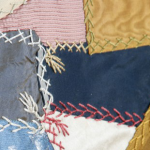
Mary Ballard, Senior Textile Conservator at the Smithsonian’s Museum Conservation Institute, joined us online to answer to questions about the storage and handling of historic textiles and costumes.
Recorded: Wednesday, August 17, 2011
Duration: Approx. 58 min.
Guest Expert:
Mary Ballard, Senior Textile Conservator, Smithsonian Museum Conservation Institute
Featured Resource:
- Smithsonian Institution’s Museum Conservation Institute Taking Care web site section on textile care.
- Storage and Handling of Textiles Power Point presentation
Host:
Kristen Laise, Vice President, Collections Care Programs, Heritage Preservation
PLEASE NOTE: The archive will launch in a new window; please make sure that pop-up blockers are turned off.
Additional Resources:
- A Note on Clothes Moths from Mary Ballard: Moths arrive in a museum from somewhere else; they begin to feed in one spot. It is important to locate the source and the ‘hot spot’ of the infestation. Think like a moth—what do they like? What would be the most appetizing spot? Clothes moths require high humidity, dark, undisturbed storage. They prefer a diet of vitamin B-12 and fish meal. A classic source of (larder)moths in the home is from pet food spilled and left under/behind a shelf; in small museums, the walled in fireplace or other cavity may be the resting place for the corpse of a small rodent. Moths and carpet beetles will thrive in such a protected situation. In display areas, the carpet that was folded under (because it was too big for the gallery) may be a perfect spot after a number of gallery openings leaves it less than pristine. Clean wool textiles are less appetizing than soiled wool with food stains on it. Moths are practical: they will not leave a spot as long as there is sufficient food. If you have a wide ranging infestation—you have a destroyed object somewhere, an object that was a major food source that has been used up. As the progeny molt and become dults you will have successive bouts of flying moths as they seek a new and tasty harborage to start devouring. The only thing left will be their frass—they cannot digest dyes, so a sandy pile of turquoise may be the remains of a carpet. Inspection and vacuuming are the type of monitoring required because with close, observation vacuuming any change or stain will be noticed and can be addressed. The more you know about the clothes moths the better off your museum will be. Maillis’s Pest Control Handbook is the bible of the industry. Buy the latest edition you can afford!
- How to Make a Tissue Paper Roll for Textile and Costume Storage
- Effect of Temperature Change on Relative Humidity
- Absolute vs. Relative Humidity
- Moisture Source by Type
- The Museum Conservation Institute maintains a library of now 35,000 articles on conservation and conservation science, including information on pest control, fumigation, mounting and storage practices, etc. The index catalogue is known as BCIN, the Bibliographic Database of the Conservation Information Network, is the Web’s most complete bibliographic resource for the conservation, preservation and restoration of cultural property. Search here on the topic that interests you. Sometimes the abstract provides enough information to answer a question. Sometimes you will want the entire article. If the article has a MCI number, then there is a copy in the MCI library. Contact Ann N’Gadi for a copy to be sent to you free of charge, but please limit requests to five or fewer articles at a time. If the article(s) is short, she may be able to email you back a pdf copy. If you require an article that MCI doesn’t have, she may be able to procure it for you.
For closed captions, please access this via this link.





